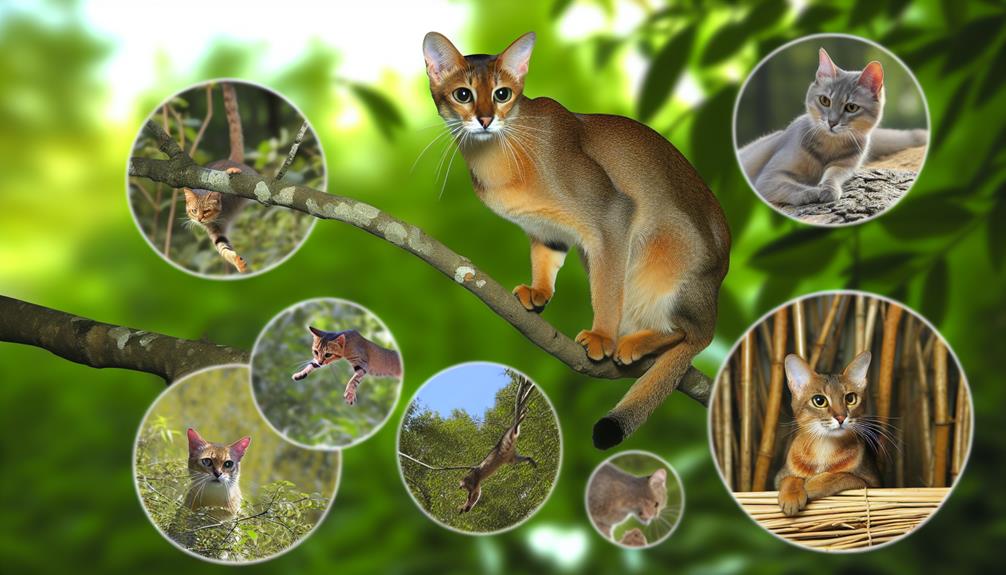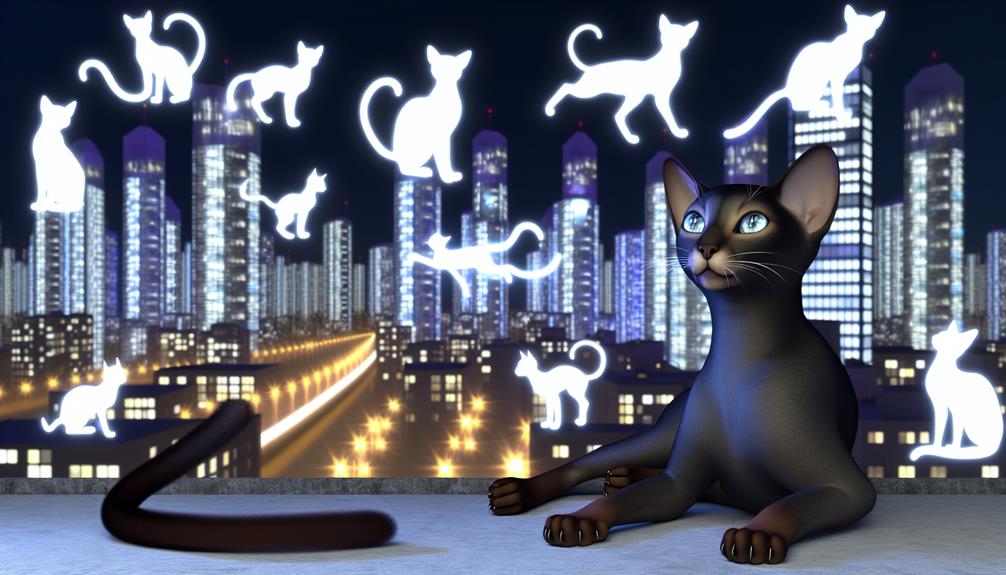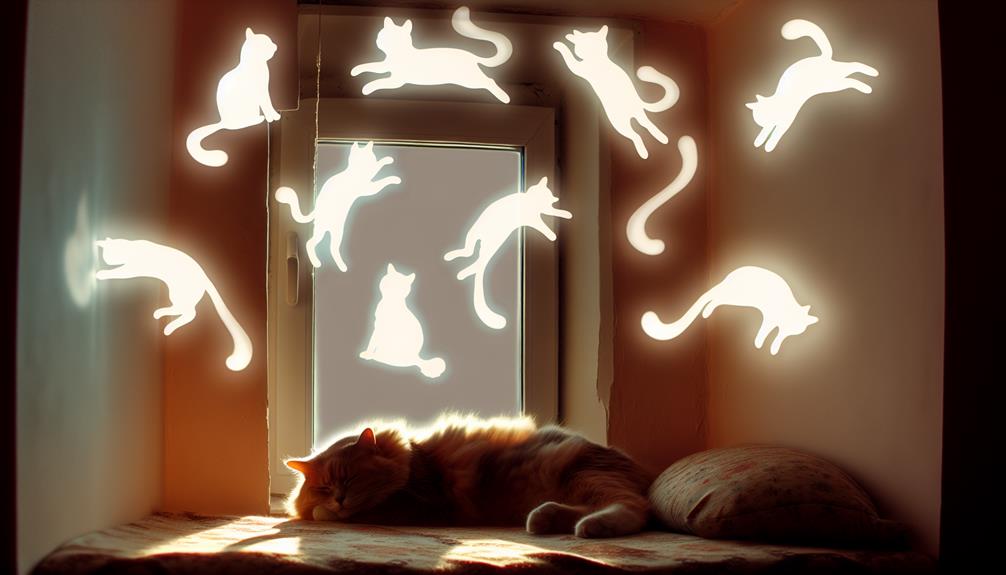You might think the notion of cats having multiple lives is just a whimsical saying, but it actually has deep cultural roots. Ancient civilizations, especially the Egyptians, revered cats as sacred beings, which contributed to this myth. Different cultures have varying interpretations; for example, Western cultures often say cats have nine lives, while Islamic traditions suggest seven. These beliefs are bolstered by cats' remarkable agility and survival skills. So, what's the truth behind this enduring myth? Let's explore further to uncover how fact and fiction intertwine in this fascinating topic.
The Origins of the Myth
The belief that cats possess multiple lives can be traced back to ancient civilizations, where their enigmatic behavior and survival instincts captivated human societies. This notion, deeply rooted in myth origins and feline folklore, has persisted through time, evolving into the widely accepted adage that a cat has nine lives.
In ancient Egypt, cats were revered and associated with the goddess Bastet, who embodied protection, fertility, and motherhood. The Egyptians observed cats' uncanny ability to survive perilous situations, which likely contributed to the myth origins. These observations led to the belief that cats had a supernatural essence, allowing them to escape death repeatedly.
Greek mythology also plays a role in feline folklore. The Greeks believed in the concept of reincarnation and attributed multiple lives to cats due to their agile nature and seemingly miraculous recoveries from injuries. Similarly, Roman culture adopted these beliefs, incorporating them into their own mythological framework.
The myth origins are further supported by the cat's physiological traits. Their flexible spine, keen reflexes, and remarkable balance contribute to their survival skills. When you observe a cat, you might notice its ability to twist mid-air to land on its feet, a phenomenon known as the "righting reflex." This ability, coupled with their acute senses, enhances their survival rate, reinforcing the belief in their multiple lives.
Cultural Interpretations
While the myth of cats having multiple lives has ancient roots, cultural interpretations vary widely across different societies. The concept is steeped in mythical symbolism and holds significant cultural importance globally. For instance, in many Western cultures, the idea of a cat having nine lives is prevalent, often associated with the animal's agility and seemingly supernatural survival skills. This belief likely stems from a blend of historical anecdotes and folklore variations that have evolved over centuries.
In contrast, some regional beliefs in Islamic culture propose that cats have seven lives. This variation underscores the flexibility of feline mythology, adapting to different cultural contexts and superstitious interpretations. The number seven itself carries mystical connotations in many traditions, enhancing the mythical symbolism attached to cats.
Artistic representations further amplify these cultural significances. Ancient Egyptian art, for example, frequently depicts cats as sacred beings, attributing them with divine qualities and, by extension, multiple lives. Such depictions offer a window into the historical reverence and superstitions surrounding felines, contributing to their storied place in human culture.
Folklore variations also abound in other regions. In China, cats are often associated with luck and protection, though the specific notion of multiple lives is less emphasized. Instead, the focus is on their role in warding off evil spirits, blending superstitious interpretations with practical beliefs.
In summation, the cultural interpretations of cats having multiple lives are rich and varied, shaped by regional beliefs, historical anecdotes, and artistic representations. These interpretations not only highlight the animal's resilience but also reflect the deep-seated superstitions and symbolic meanings humans have attributed to felines throughout history.
The Nine Lives in Literature

Delving into literature reveals how the myth of cats having nine lives has permeated various narratives, often serving as a metaphor for resilience and survival. This enduring motif can be traced through diverse genres, demonstrating the rich interplay between literary symbolism and feline folklore.
In William Shakespeare's "Romeo and Juliet," Mercutio taunts Tybalt, calling him the "King of Cats" and sarcastically referencing the notion of nine lives. Here, the myth underscores Tybalt's perceived invincibility and arrogance. Similarly, T.S. Eliot's "Old Possum's Book of Practical Cats" draws on this folklore to characterize the mysterious and seemingly indestructible nature of felines.
The following table highlights notable works that incorporate the nine-lives motif:
| Work | Author |
|---|---|
| "Romeo and Juliet" | William Shakespeare |
| "Old Possum's Book of Practical Cats" | T.S. Eliot |
| "The Master and Margarita" | Mikhail Bulgakov |
| "Puss in Boots" | Charles Perrault |
In Mikhail Bulgakov's "The Master and Margarita," the character Behemoth, a giant black cat, exemplifies the indestructible nature attributed to cats through his numerous escapades and survivals. This aligns with the feline folklore that positions cats as enigmatic and almost supernatural beings. Charles Perrault's "Puss in Boots" also leverages the myth, presenting a cat whose cleverness and agility allow him to escape dire situations repeatedly.
Ultimately, the nine-lives myth serves as a powerful narrative device, enriching characters with a sense of tenacity and mystery. It's clear that literary symbolism and feline folklore have combined to create a lasting legacy in literature, showcasing cats as symbols of resilience and survival.
Scientific Perspective
Literary depictions of cats' nine lives might capture the imagination, but what does science say about the resilience of felines? From a scientific perspective, cats' reputed ability to survive falls and other hazards can be attributed to several aspects of feline biology and evolutionary adaptations.
First, consider the feline skeletal structure. Cats possess a highly flexible spine and unique skeletal arrangement, lacking a collarbone, which enables them to twist their bodies mid-air. This phenomenon, known as the "righting reflex," allows cats to land on their feet after a fall, markedly reducing the risk of injury. Their small, lightweight bodies also minimize the impact force upon landing.
Additionally, cats' evolutionary adaptations play an essential role in their survival. As natural predators, they have developed acute senses and swift reflexes. Their sharp vision, even in low light, and sensitive whiskers enable them to detect and react to threats with remarkable speed. Furthermore, their retractable claws and muscular build provide agility and strength, fundamental for climbing and escaping danger.
Feline biology also includes a highly efficient cardiovascular system. Cats have a rapid heart rate and strong muscles, which contribute to their ability to make quick bursts of speed, important when evading predators or maneuvering challenging environments. Moreover, their grooming behavior not only maintains hygiene but also helps in wound care, reducing infection risk.
Survival Skills of Cats

In the domain of feline survival skills, cats exhibit a remarkable array of behaviors and physical adaptations that enhance their ability to thrive in diverse environments. These survival instincts encompass a series of complex hunting techniques, predatory instincts, and problem-solving abilities that are finely honed through both instinctual behaviors and learned experiences.
Cats possess an intrinsic ability to adapt to various environments, whether urban landscapes or rural terrains. Their environmental adaptability is evident in their capacity to modify hunting techniques based on prey availability and habitat. For instance, in urban settings, they may rely on stealth and ambushes to capture smaller prey, whereas in rural areas, they might engage in more prolonged pursuit strategies.
Social interactions among cats also play a crucial role in their survival. While often perceived as solitary hunters, cats do exhibit social behaviors, particularly in feral colonies or domestic settings. These interactions can enhance their survival by fostering cooperative behaviors, such as shared vigilance and communal grooming, which can reduce stress and increase overall health.
Territorial behavior is another essential aspect of feline survival skills. By marking and defending their territory, cats guarantee a stable supply of resources and reduce the likelihood of conflicts with other predators. This territoriality is often maintained through scent marking and vocalizations, which serve as both deterrents to intruders and signals to potential mates.
Moreover, the problem-solving abilities of cats are well-documented. They demonstrate considerable ingenuity in overcoming obstacles to access food, shelter, and mates. Their cognitive flexibility allows them to exploit new opportunities and avoid potential threats, underscoring their robust survival instincts.
Agility and Reflexes
You'll notice cats exhibit remarkable agility and quick reflex actions, essential for their survival. Their flexible body mechanics, including a highly flexible spine and absence of a rigid clavicle, enable them to twist mid-air and land on their feet. These physical adaptations greatly contribute to the myth of cats having multiple lives.
Quick Reflex Actions
Cats are renowned for their quick reflex actions, a vital aspect of their agility and overall survival. This remarkable ability is attributed to their highly developed nervous system and muscular coordination. When you observe a cat in motion, you'll notice its rapid response to stimuli, a product of both innate prowess and reflex training during its developmental stages.
At the core of cat agility lies the vestibular apparatus, a component of the inner ear that maintains balance and spatial orientation. This system allows cats to make precise, split-second adjustments to their posture and movement. Additionally, the fast-twitch muscle fibers in a cat's body enable rapid contractions, facilitating sudden bursts of speed and nimble maneuvers.
A cat's reflex actions are also evident in their righting reflex, which allows them to twist their bodies mid-air to land on their feet. This reflex is activated within milliseconds of detecting a fall, showcasing the efficiency of their sensory and motor pathways. Such capabilities are not just inherent but are honed through playful activities and hunting exercises, further enhancing their reflexes and overall agility. Understanding these mechanisms underscores the extraordinary adaptability and survival skills of felines.
Flexible Body Mechanics
Building on the foundation of quick reflex actions, a cat's flexible body mechanics further enhance its agility and reflexes. The feline anatomy is uniquely designed with a highly flexible spine, numerous vertebrae, and elastic cushioning between each bone. This anatomical structure allows cats to twist their bodies mid-air, enabling them to land on their feet—a phenomenon known as the "righting reflex."
You'll notice that a cat's collarbone (clavicle) is free-floating, not attached to other bones like in most mammals. This increases their range of motion, facilitating greater body flexibility. Additionally, cats possess powerful, well-coordinated muscle groups that allow for rapid acceleration and sudden stops. Their hind limbs are particularly strong, providing the burst of power necessary for high jumps and quick sprints.
Further enhancing their agility, cats' semi-retractable claws offer superior grip when climbing or making sharp turns. Their flexible musculature and joint configuration permit an extraordinary range of movement, contributing to their reputation for nimbleness. Understanding these elements of feline anatomy underscores why cats appear to have multiple "lives," as their body mechanics considerably reduce the risk of injury from falls and other hazards.
Modern-Day Beliefs

In contemporary society, the belief that cats possess multiple lives, often quantified as nine, persists as a charming myth rather than a factual assertion. This notion is deeply rooted in superstitious beliefs and feline folklore, which have transcended generations and cultures. While you might enjoy the whimsical idea that your cat has multiple chances at life, it's essential to understand that this concept lacks scientific grounding.
Modern-day beliefs about cats and their so-called multiple lives can be traced back to various cultural narratives. For instance, in some cultures, cats are seen as mystical creatures with special powers, which could explain why such myths endure. Despite the absence of empirical evidence, these beliefs continue to captivate the imagination of many.
| Belief Origin | Cultural Interpretation |
|---|---|
| Ancient Egypt | Cats considered sacred; believed to possess protective qualities. |
| Medieval Europe | Seen as witches' familiars; thought to have supernatural resilience. |
| Contemporary Media | Popularized in literature and films, reinforcing the myth. |
From a clinical perspective, the misconception that cats have nine lives can be attributed to their remarkable agility and ability to survive situations that would be fatal to other animals. Their flexible spine, keen reflexes, and ability to right themselves during a fall contribute to this enduring myth. However, attributing these survival skills to multiple lives rather than biological prowess is a simplification.
Understanding the origins and persistence of these superstitious beliefs can enrich your appreciation of feline folklore. While it's fun to indulge in the myth, always remember that your cat, like all living beings, has only one life, making its care and well-being all the more important.
Conclusion
In principle, the myth of cats having nine lives is deeply rooted in cultural reverence and their extraordinary survival skills. Picture a cat traversing a tightrope with unerring precision—that's their agility and reflexes at play. While modern science debunks the literal notion, it's undeniable that cats' resilience and adaptability are awe-inspiring. So, while cats don't really have nine lives, their remarkable abilities make it seem like they do.
